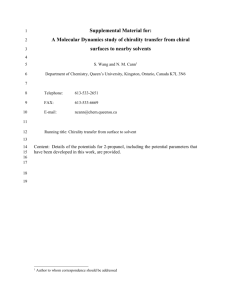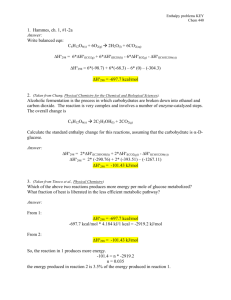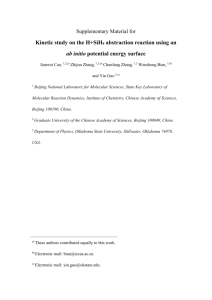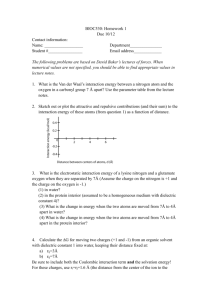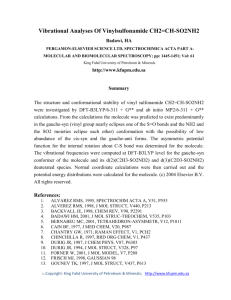Mechanism of Thermal Reversal of the (Fulvalene)
advertisement
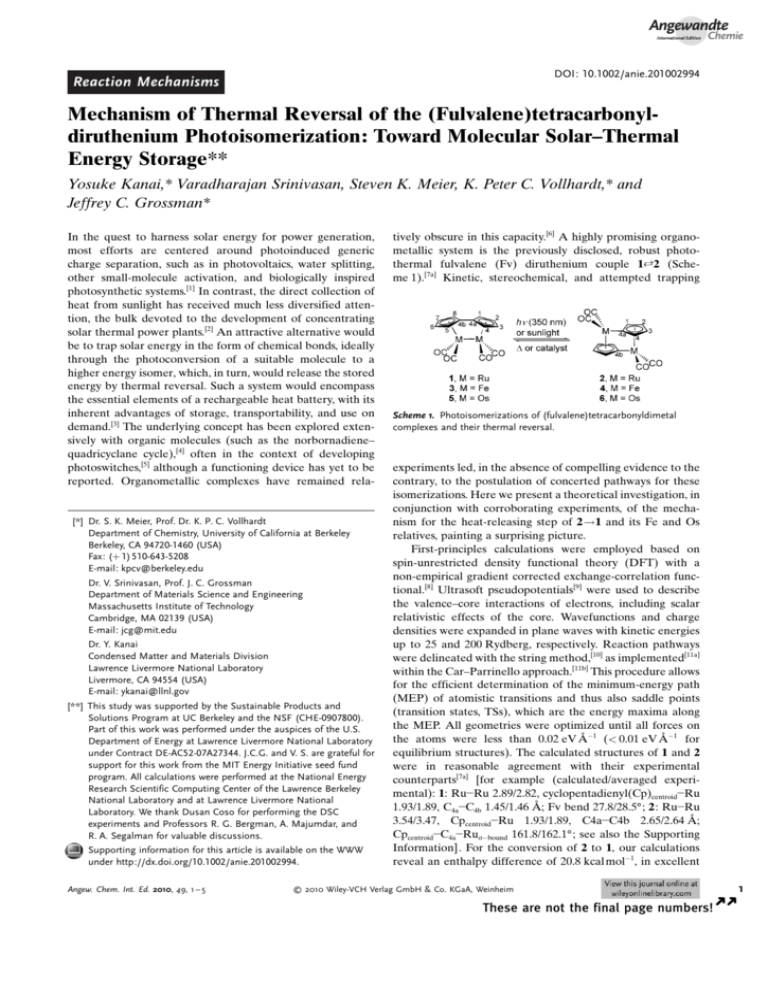
Angewandte Chemie DOI: 10.1002/anie.201002994 Reaction Mechanisms Mechanism of Thermal Reversal of the (Fulvalene)tetracarbonyldiruthenium Photoisomerization: Toward Molecular Solar–Thermal Energy Storage** Yosuke Kanai,* Varadharajan Srinivasan, Steven K. Meier, K. Peter C. Vollhardt,* and Jeffrey C. Grossman* In the quest to harness solar energy for power generation, most efforts are centered around photoinduced generic charge separation, such as in photovoltaics, water splitting, other small-molecule activation, and biologically inspired photosynthetic systems.[1] In contrast, the direct collection of heat from sunlight has received much less diversified attention, the bulk devoted to the development of concentrating solar thermal power plants.[2] An attractive alternative would be to trap solar energy in the form of chemical bonds, ideally through the photoconversion of a suitable molecule to a higher energy isomer, which, in turn, would release the stored energy by thermal reversal. Such a system would encompass the essential elements of a rechargeable heat battery, with its inherent advantages of storage, transportability, and use on demand.[3] The underlying concept has been explored extensively with organic molecules (such as the norbornadiene– quadricyclane cycle),[4] often in the context of developing photoswitches,[5] although a functioning device has yet to be reported. Organometallic complexes have remained rela- [*] Dr. S. K. Meier, Prof. Dr. K. P. C. Vollhardt Department of Chemistry, University of California at Berkeley Berkeley, CA 94720-1460 (USA) Fax: (+ 1) 510-643-5208 E-mail: kpcv@berkeley.edu Dr. V. Srinivasan, Prof. J. C. Grossman Department of Materials Science and Engineering Massachusetts Institute of Technology Cambridge, MA 02139 (USA) E-mail: jcg@mit.edu Dr. Y. Kanai Condensed Matter and Materials Division Lawrence Livermore National Laboratory Livermore, CA 94554 (USA) E-mail: ykanai@llnl.gov [**] This study was supported by the Sustainable Products and Solutions Program at UC Berkeley and the NSF (CHE-0907800). Part of this work was performed under the auspices of the U.S. Department of Energy at Lawrence Livermore National Laboratory under Contract DE-AC52-07A27344. J.C.G. and V. S. are grateful for support for this work from the MIT Energy Initiative seed fund program. All calculations were performed at the National Energy Research Scientific Computing Center of the Lawrence Berkeley National Laboratory and at Lawrence Livermore National Laboratory. We thank Dusan Coso for performing the DSC experiments and Professors R. G. Bergman, A. Majumdar, and R. A. Segalman for valuable discussions. Supporting information for this article is available on the WWW under http://dx.doi.org/10.1002/anie.201002994. Scheme 1. Photoisomerizations of (fulvalene)tetracarbonyldimetal complexes and their thermal reversal. experiments led, in the absence of compelling evidence to the contrary, to the postulation of concerted pathways for these isomerizations. Here we present a theoretical investigation, in conjunction with corroborating experiments, of the mechanism for the heat-releasing step of 2!1 and its Fe and Os relatives, painting a surprising picture. First-principles calculations were employed based on spin-unrestricted density functional theory (DFT) with a non-empirical gradient corrected exchange-correlation functional.[8] Ultrasoft pseudopotentials[9] were used to describe the valence–core interactions of electrons, including scalar relativistic effects of the core. Wavefunctions and charge densities were expanded in plane waves with kinetic energies up to 25 and 200 Rydberg, respectively. Reaction pathways were delineated with the string method,[10] as implemented[11a] within the Car–Parrinello approach.[11b] This procedure allows for the efficient determination of the minimum-energy path (MEP) of atomistic transitions and thus also saddle points (transition states, TSs), which are the energy maxima along the MEP. All geometries were optimized until all forces on the atoms were less than 0.02 eV 1 (< 0.01 eV 1 for equilibrium structures). The calculated structures of 1 and 2 were in reasonable agreement with their experimental counterparts[7a] [for example (calculated/averaged experimental): 1: RuRu 2.89/2.82, cyclopentadienyl(Cp)centroidRu 1.93/1.89, C4aC4b 1.45/1.46 ; Fv bend 27.8/28.58; 2: RuRu 3.54/3.47, CpcentroidRu 1.93/1.89, C4aC4b 2.65/2.64 ; CpcentroidC4aRusbound 161.8/162.18; see also the Supporting Information]. For the conversion of 2 to 1, our calculations reveal an enthalpy difference of 20.8 kcal mol1, in excellent 1 2010 Wiley-VCH Verlag GmbH & Co. KGaA, Weinheim Ü Ü Angew. Chem. Int. Ed. 2010, 49, 1 – 5 tively obscure in this capacity.[6] A highly promising organometallic system is the previously disclosed, robust photothermal fulvalene (Fv) diruthenium couple 1Q2 (Scheme 1).[7a] Kinetic, stereochemical, and attempted trapping These are not the final page numbers! Communications accord with the experimental value, (19.8 1.4) kcal mol1.[7b, 12a] This value corresponds to an energy density of approximately 0.2 MJ kg1, comparable to that of lithium ion batteries (0.5 MJ kg1). An initial search for a concerted mechanism for the isomerization (vide supra)[7a] was executed by string-method optimization of a simple rotation of one Ru unit relative to the other. However, the string (path) evolved away from this motion, and a two-step process was uncovered, in which 2 rearranges by initial CpCp coupling via TS A to deliver Figure 1. Key structures along the minimum-energy path for the thermal reversal reaction of 2 to 1. Isomer 2 proceeds via transition state A to the anti-[FvRu2(CO)4] diradical intermediate B, which continues via transition state C to 1. See the Supporting Information for key structural parameters. 2 Ü Ü biradical intermediate B, which in turn progresses through TS C to 1 (Figure 1).[12b] Proceeding along this reaction coordinate, the first step defines a surprising (vide infra) preequilibrium and involves an unusual TS structure (A), which is 22.4 kcal mol1 higher in energy than 2 (Figure 2). It can be viewed as a pseudo-tripledecker complex, in which the bridging Fv ligand contains two nearly planar Cp halves twisted by 46.38 with respect to each other. The length of the nascent CC bond is 1.54 , elongated, but well on the way to that in B (1.43 ). This connection, featuring two formally pentacoordinate carbon atoms, bridges the two Ru atoms unsymmetrically, each side exhibiting a short (2.21, 2.21 ) and a long RuC linkage (2.39, 2.43 ). A tantalizingly close topological analogy is the structure of the isoelectronic anti-[Cp2Ru2(m-cyclooctatetraene)], in which the corresponding bond (1.57 ) is also reversibly cleaved, but only on two-electron oxidation– reduction.[13] Diradical B lies 18.0 kcal mol1 above 2. Equating the CpCp bond energy in B to that in biphenyl (118 kcal mol1)[14] provides an estimate of the strength of the CpRu s bond of 68 kcal mol1.[15] The structure of B features the anti-[FvM2] configuration, with a pyramidalized Ru stereochemistry [CpcentroidRu(CCOCCO)centroid = 161.28] that is similar to that observed in the crystallographically characterized, isoelectronic 17e [Cp*Fe(dppe)] (167.88) (Cp* = C5Me5, dppe = 1,2-bis(diphenylphosphino)ethane).[16] Unexpectedly, in light of the normally diffusion-limited dimerization of 17e [CpM] species,[17] the rate-determining step of the thermal reversal of 2 is controlled by the steric hindrance of the rotation of the CpCp bond,[18] 11.7 kcal mol1, before the formation of the RuRu bond, as indicated www.angewandte.org Figure 2. Calculated potential energy profiles [kcal mol1] for the thermal reversal reactions of the photoisomers 2 (Ru), 4 (Fe), and 6 (Os), all with a reference energy of 0 kcal mol1, to the corresponding fulvalene complexes 1, 3, and 5. A and C correspond to transition states, while B is an intermediate in the reaction. See the Supporting Information for the structural evolution of 2 along the minimumenergy path. by C. Here, the CpCp distance lengthens to 1.48 , thus minimizing the RuCpHa encumbrance, 2.66 , which is still well within van der Waals distance.[19] The measured barrier for the thermal reversal reaction from 2 to 1 is (29.9 2) kcal mol1. To address this quantity computationally, we solved numerically a set of rate equations for 2QBQ1, using the calculated reaction energetics (see the Supporting Information). The preequilibrium 2QB was found to be established extremely rapidly, and the effective barrier from 2 to 1 computed at 29.7 kcal mol1,[12a] corresponding to the energy difference between 2 and C. Conversely, the barrier for RuRu bond dissociation in 1 is calculated at 50.5 kcal mol1, consistent with the extraordinary thermal stability of this compound (m.p. 288–290 8C), and the computed RuRu bond strength (estimated from the energy difference between B and 1) is 38.8 kcal mol1, close to a value previously suggested (35 kcal mol1).[7a] An important consequence of the computed mechanism is the presence of a preequilibrium 2QB on the way to 1, a facet that explains some peculiar experimental observations.[7a] Thus, the observed accelerated disappearance of 2 with added CCl4 and concomitant appearance of [FvRu2(CO)4Cl2] as a product can now be rationalized by the competitive trapping of B with the additive. Indeed, a reinvestigation of this reaction in toluene charged with increasing amounts of CCl4 at 70 8C revealed saturation kinetics from which DG°70 8C = (25.6 0.5) kcal mol1 was obtained. This value is consistent with the calculated barrier of DH°DFT = 22.4 kcal mol1 for the preequilibrium step (A; Figure 1 and Figure 2). 2010 Wiley-VCH Verlag GmbH & Co. KGaA, Weinheim These are not the final page numbers! Angew. Chem. Int. Ed. 2010, 49, 1 – 5 Angewandte Chemie Angew. Chem. Int. Ed. 2010, 49, 1 – 5 These results may be of relevance to other topologically related rearrangements.[24] We are currently constructing a proof-of-principle device, based on derivatives of 1 and the discovery of catalysts obviating thermal activation of 2,[25] to demonstrate the feasibility of the concept. Received: May 17, 2010 Published online: && &&, 2010 . Keywords: ab initio calculations · CC activation · isomerization · photochemistry · ruthenium [1] For some illustrative reviews, see: a) Acc. Chem. Res. Special Issue: Artificial Photosynthesis and Solar Fuels, 2009, 42, 1861 – 2029; b) A. Carroll, C. Somerville, Annu. Rev. Plant Biol. 2009, 60, 165 – 182; c) V. Balzani, A. Credi, M. Venturi, ChemSusChem 2008, 1, 26 – 58; d) V. S. Arunachalam, E. S. Fleischer, MRS Bull. 2008, 33, 265 – 275; e) N. Lewis, D. G. Nocera, Proc. Natl. Acad. Sci. USA 2006, 103, 15729 – 15735. [2] See, inter alia: a) L. Schnatbaum, Eur. Phys. J. Special Topics 2009, 176, 127 – 140; b) M. Kenisarin, K. Mahkamov, Renewable Sustainable Energy Rev. 2007, 11, 1913 – 1965. [3] For a review of the problems of energy storage, see: H. Chen, T. N. Cong, W. Yang, C. Tan, Y. Li, Y. Ding, Prog. Nat. Sci. 2009, 19, 291 – 312. [4] For recent work, see: a) J.-J. Zou, Y. Liu, L. Pan, L. Wang, X. Zhang, Appl. Catal. B 2010, 95, 439 – 445; b) E. Vesally, Russ. J. Phys. Chem. A 2009, 83, 809 – 812, and references therein. [5] For selected general reviews, see: a) V. Balzani, A. Credi, M. Venturi, Chem. Soc. Rev. 2009, 38, 1542 – 1550; b) E. R. Kay, D. A. Leigh, F. Zerbetto, Angew. Chem. 2007, 119, 72 – 196; Angew. Chem. Int. Ed. 2007, 46, 72 – 191; c) Photochromism, Molecules and Systems (Eds.: H. Drr, H. Bouas-Laurent), Elsevier, Amsterdam, 2003. [6] For a recent review, see: a) M.-S. Wang, G. Xu, Z.-J. Zhang, G.C. Guo, Chem. Commun. 2010, 46, 361 – 376; for some recent examples, see: b) B. A. McClure, E. R. Abrams, J. J. Rack, J. Am. Chem. Soc. 2010, 132, 5428 – 5436; c) T. A. Albright, P. I. Dosa, T. N. Grossmann, V. N. Khrustalev, O. A. Oloba, R. Padilla, R. Paubelle, A. Stanger, T. V. Timofeeva, K. P. C. Vollhardt, Angew. Chem. 2009, 121, 10037 – 10041; Angew. Chem. Int. Ed. 2009, 48, 9853 – 9857; d) A. Ben-Asuly, A. Aharoni, C. E. Diesendruck, Y. Vidavsky, I. Goldberg, B. F. Straub, N. G. Lemcoff, Organometallics 2009, 28, 4652 – 4655; e) G. Zhu, K. Pang, G. Parkin, J. Am. Chem. Soc. 2008, 130, 1564 – 1565; f) K. Tsuchiya, K. Ideta, K. Mogi, Y. Sunada, H. Nagashima, Dalton Trans. 2008, 2708 – 2716; g) H. Nakai, T. Nonaka, Y. Miyano, M. Mizuno, Y. Ozawa, K. Toriumi, N. Koga, T. Nishioka, M. Irie, K. Isobe, J. Am. Chem. Soc. 2008, 130, 17836 – 17845; h) S. Miyazaki, T. Kojima, S. Fukuzumi, J. Am. Chem. Soc. 2008, 130, 1556 – 1557; i) H. C. Jahr, M. Nieger, K. H. Dtz, Chem. Eur. J. 2005, 11, 5333 – 5342. [7] a) R. Boese, J. K. Cammack, A. J. Matzger, K. Pflug, W. B. Tolman, K. P. C. Vollhardt, T. W. Weidman, J. Am. Chem. Soc. 1997, 119, 6757 – 6773; b) the originally reported enthalpy change of 29.8 kcal mol1 for the thermal reverse reaction (2!1) was overestimated due to an error in integration of the differential scanning calorimetry (DSC) curve. The new measurement is based on an average of six runs (TA Instruments DSC 2920 and Q20). [8] J. P. Perdew, K. Burke, M. Ernzerhof, Phys. Rev. Lett. 1996, 77, 3865 – 3868. [9] D. Vanderbilt, Phys. Rev. B 1990, 41, 7892 – 7895. [10] E. Weinan, W. Ren, E. Vanden-Eijnden, Phys. Rev. B 2002, 66, 052301. 2010 Wiley-VCH Verlag GmbH & Co. KGaA, Weinheim 3 www.angewandte.org Ü Ü Finally, one notes that the barrier for the conversion of B to 2 is only 4.4 kcal mol1, reviving the initially discounted possibility that the photochemical step from 1 to 2 also proceeds through the intermediacy of B.[7a] The finding that CCl4 as a solvent does not affect this step may simply be due to noncompetitive intermolecular trapping kinetics at room temperature.[20] This extraordinary labilization of the normally strong Fv linkage by the homolysis of a metalmetal bond has been an unrecognized feature in this class of compounds. To further explore the scope of the photothermal system, in particular the possibility of using the cheaper and environmentally and economically more favorable Fe analogues, the potential energy manifold of 3Q4 and, for completion of the triad elements, briefly also 5Q6, were scrutinized (Scheme 1, Figure 2). For the former, the photochemical energy storage potential (15.9 kcal mol1) is diminished relative to that of its Ru relative. In addition, the rate-determining transition state is now that of the first step leading to the biradical and the computed effective barrier is much smaller (17.3 kcal mol1). Consequently, the nature of the thermal reversal reaction changes for the Fe case, likely the combined result of the weaker metalCp s bond in 4 and the diminished FeCpHa interaction (2.76 ) in C relative to the corresponding values for Ru. The significantly lower kinetic and thermal stability of photoisomer 4 might preclude its isolation. Experimentally, the 2,3,6,7-tetra-tert-butyl derivative of 3 was observed to be (seemingly) photoinert, possibly because of fast thermal reversal at the ambient temperatures employed.[21] Indeed, the computed rate for this process is several orders of magnitude larger at room temperature than that of its Ru analogue (see the Supporting Information). The computations also give an estimate of the Fv(FeFe) bond strength, 25.4 kcal mol1, which is comparable to that in [CpFe(CO)2]2, 26.9 2.7 kcal mol1.[22] In comparison, the Os system is estimated to be an even poorer photoenergy storage molecule (10.2 kcal mol1) and appears to traverse a prohibitively energetic reversal manifold, as judged from the high energy of the diradical intermediate (42 kcal mol1 above 6; approximate OsOs bond strength 52.2 kcal mol1).[23] Given these findings, an MEP for the Os case was not addressed. Preliminary experiments reveal that the 2,3,6,7-tetra-tertbutyl derivative of 5, while it photoisomerizes to the correspondingly substituted 6, cannot be regenerated thermally even at temperatures as high as 275 8C (phenyloctane solvent).[21] In conclusion, we have investigated the detailed mechanism of the thermal reversal reaction of the photoisomer 2 of [FvRu2(CO)4] (1), a representative of a promising platform for storing solar energy using organometallic molecules. In contrast to earlier suggestions, our first-principles calculations predict the existence of a diradical intermediate B with a surprisingly low barrier for CpCp bond rupture to furnish 2 and an equally unexpected high barrier to rotation to (re)generate 1. The new mechanism uncovered by the calculations is consistent with all experimental findings. An extension to the Fe and Os relatives of this system reveals quantitatively very different thermodynamic and kinetic aspects, also corroborated by preliminary experiments. These are not the final page numbers! Communications 4 Ü Ü [11] a) Y. Kanai, A. Tilocca, A. Selloni, R. Car, J. Chem. Phys. 2004, 121, 3359 – 3367; b) R. Car, M. Parrinello, Phys. Rev. Lett. 1985, 55, 2471 – 2474. [12] a) We emphasize that the excellent agreement (i. e., within 1 kcal mol1) of some of the experimental values with those computed by DFT calculations is fortuitous, albeit gratifying; b) We compute a singlet ground state for B, 13.6 kcal mol1 more stable than the triplet. The singlet–triplet splitting for 1 and 2 is 51.9 and 72.6 kcal mol1, respectively. [13] W. E. Geiger, A. Salzer, J. Edwin, W. von Philipsborn, U. Piantini, A. L. Rheingold, J. Am. Chem. Soc. 1990, 112, 7113 – 7121. [14] a) NIST Chemistry WebBook; see also: b) K. Elihn, K. Larsson, Thin Solid Films 2004, 458, 325 – 329. [15] a) J. A. M. Simes, J. L. Beauchamp, Chem. Rev. 1990, 90, 629 – 688; compare [TpRuII(CO)(CH3CN)CH3] (Tp = hydridotris(pyrazolyl)borate), 48.6 kcal mol1: b) M. Lail, T. B. Gunnoe, K. A. Barakat, T. R. Cundari, Organometallics 2005, 24, 1301 – 1305, and the typical correction increment for phenyl, 12–15 kcal mol1. [16] a) P. Hamon, L. Toupet, J.-R. Hamon, C. Lapinte, Organometallics 1996, 15, 10 – 12; see also: b) K. Costuas, J.-Y. Saillard, Organometallics 1999, 18, 2505 – 2512. [17] See, e.g.: X. Z. Sun, S. M. Nikiforov, A. Dedieu, M. W. George, Organometallics 2001, 20, 1515 – 1520. [18] This barrier in [FvRh2(CO)4], in which the metal has pseudotrigonal coordination, has been estimated to be < 5 kcal mol1: www.angewandte.org [19] [20] [21] [22] [23] [24] [25] T. T. Chin, W. E. Geiger, A. L. Rheingold, J. Am. Chem. Soc. 1996, 118, 5002 – 5010. S.-Z. Hu, Z.-H. Zhou, B. E. Robertson, Z. Kristallogr. 2009, 224, 375 – 383. See also remarks by: T. E. Bitterwolf, J. E. Shade, J. A. Hansen, A. L. Rheingold, J. Organomet. Chem. 1996, 514, 13 – 21, specifically p. 18. K. P. C. Vollhardt, B. Zhu, O. Š. Miljanić, M. J. West, Synthesis 2005, 3373 – 3379 and unpublished results. a) A. R. Cutler, M. Rosenblum, J. Organomet. Chem. 1976, 120, 87 – 96; FvMM bond strengths appear to be comparable to, if not stronger, than those of their CpMMCp analogues. See: b) K. P. C. Vollhardt, J. K. Cammack, A. J. Matzger, A. Bauer, K. B. Capps, C. D. Hoff, Inorg. Chem. 1999, 38, 2624 – 2631. The DFT-calculated OsOs bond dissociation energies for [CpOs(CO)2]2 are 52.8 (BP86) and 54.6 kcal mol1 (MPW1PW91): B. Xu, Q.-S. Li, Y. Xie, R. B. King, H. F. Schaefer, III, Organometallics 2008, 27, 5921 – 5928. See, inter alia: a) M. Gonzlez-Maupoey, V. Tebernero, T. Cuenca, Coord. Chem. Rev. 2009, 253, 1854 – 1881; b) H. Sun, Q. Liu, J. Gu, C. Zhang, Z. Zhang, Q. Wang, Organometallics 2008, 27, 4505 – 4512, and references therein; c) D. Chen, J. Guo, S. Xu, H. Song, B. Wang, Organometallics 2007, 26, 4212 – 4219, and references therein; d) M. Berry, N. J. Cooper, M. L. H. Green, S. J. Simpson, J. Chem. Soc. Dalton Trans. 1980, 29 – 40. K. P. C. Vollhardt, R. A. Segalman, A. Majumdar, S. Meier, PCT Int. Appl. WO 2010009052 A2 2010,[Chem. Abstr. 2010, 152, 196 421]. 2010 Wiley-VCH Verlag GmbH & Co. KGaA, Weinheim These are not the final page numbers! Angew. Chem. Int. Ed. 2010, 49, 1 – 5 Angewandte Chemie Communications Y. Kanai,* V. Srinivasan, S. K. Meier, K. P. C. Vollhardt,* J. C. Grossman* &&&&—&&&& Mechanism of Thermal Reversal of the (Fulvalene)tetracarbonyldiruthenium Photoisomerization: Toward Molecular Solar–Thermal Energy Storage Angew. Chem. Int. Ed. 2010, 49, 1 – 5 A closer look at the title reaction pinpoints a surprising mechanism—a relatively rapid preequilibrium between cyclopentadienyl complex 2 and fulvalene diradical complex 1 precedes the ratedetermining anti–syn rotation and formation of the RuRu bond. The computed energy values agree well with all experimental data, including saturation kinetics for the trapping of the intermediate by CCl4. TS = transition state. 2010 Wiley-VCH Verlag GmbH & Co. KGaA, Weinheim 5 www.angewandte.org Ü Ü Reaction Mechanisms These are not the final page numbers!

